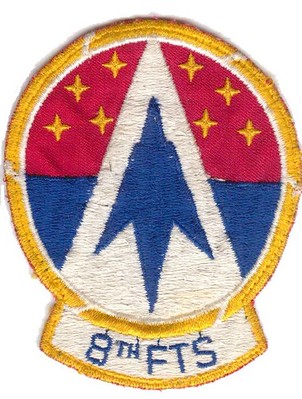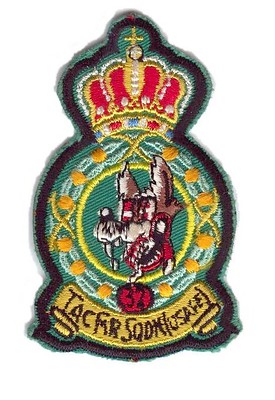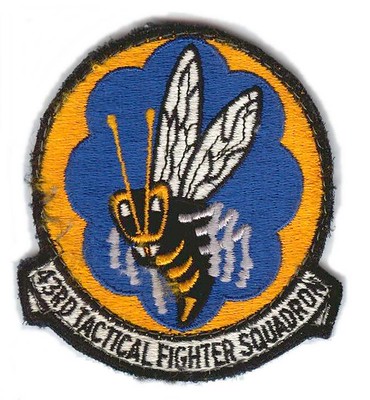I completed four operational flying assignments as a pilot in the United States Air Force. My career, with its balance of operational and staff assignments, was more or less typical for USAF pilots of my generation. What was different … and I’m sure it was nothing more than happenstance … is that the flying squadrons my family and I called home were not only low-numbered ones, but came in ascending numerical order: from the 8th Flying Training Squadron to the 32nd Tactical Fighter Squadron, then on to the 43rd TFS and finally the 44th TFS.* How many USAF veterans can say that?
The 8th FTS no doubt had a unit nickname in WWII, when it flew reconnaissance missions in the Pacific, but not when I was part of it … it was just the 8th FTS. What would you even call that thing on the patch? A really fast bird?
The 32nd TFS, originally based in Panama and the Caribbean during WWII, in its Cold War incarnation was part of United States Air Forces Europe, based in the Netherlands. Incidentally, the 32nd was the only USAFE unit authorized to incorporate host-nation royal colors on its emblem (those of the House of Orange), which also sported a Walt Disney-designed wolfhound. Members of the unit called themselves Wolfhounds; the wolfhound on the patch was the Slobbering Dog.
The history of the 43rd TFS goes back to its 43rd Aero Squadron roots in WWI, and it’s had a hornet on its patch since the mid-1920s.
The 44th TFS has bounced around the Pacific theater since WWII, and members call themselves Vampires, sometimes Bats. I don’t know who designed the patch, but I’m told any resemblance to the Bacardi rum bat is coincidental.
My first flying assignment after earning my wings was as a T-37 instructor pilot in the 8th FTS, part of Air Training Command’s 71st Flying Training Wing at Vance AFB, Oklahoma. I was an 8th FTS IP for three years, from March 1975 to March 1978, training student pilots to fly and master the Tweet before sending them off to T-38s and the advanced phase of pilot training. Coincidentally, I myself learned to fly in the Tweet in the same squadron when I went through pilot training.
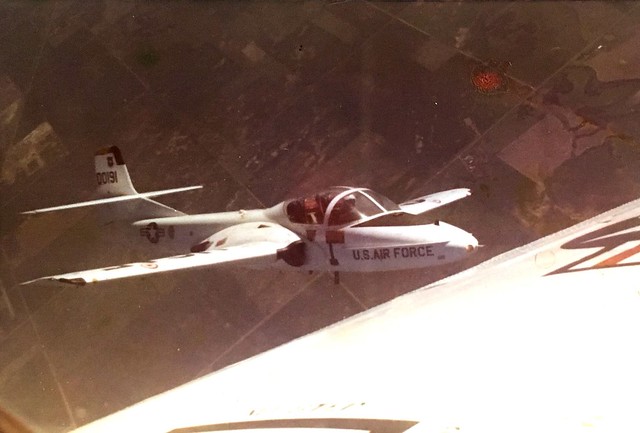
As my tour with the 8th FTS wrapped up, I got a bit of good news: the USAF had selected me to fly the newest and hottest fighter in the inventory, the F-15 Eagle. The process of turning by-the-numbers training command instructor pilots into steely-eyed aerial assassins was an intense nine-month process, almost as long as pilot training itself. After fighter lead-in training in T-38s at Holloman AFB, New Mexico, I went through the F-15 schoolhouse at Luke AFB, Arizona, then on to NATO top-off training at Langley AFB, Virginia. I reported to my first operational fighter squadron in December 1978: the 32nd Tactical Fighter Squadron at Soesterberg AB in the Netherlands. I was a 32nd TFS Wolfhound, holder of one of the USAF’s most coveted fighter billets, for slightly more than three years, from the end of 1978 to March of 1982.
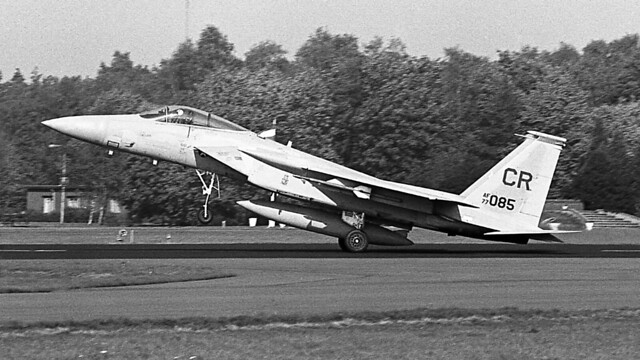
In early 1982 word got out that Alaskan Air Command was going to convert its two F-4 Phantom II squadrons: one to A-10 Warthogs and the other to F-15 Eagles. An experienced F-15 flight lead and instructor pilot by this time, I was selected to be part of the F-15 conversion cadre for the 43rd TFS at Elmendorf AFB in Anchorage, Alaska, and was the second Eagle driver to report there. Larry Crumrine and I didn’t have any Eagles to fly for about two months, but we stayed busy designing the conversion program, a totally in-house effort with no help from the USAF (then-Alaska Senator Ted Stevens had pushed through the allocation of F-15s and A-10s to Alaska against USAF wishes … we were often referred to as “Ted Steven’s Air Force”). Crumer and I pulled it off somehow, and I spent the next three-plus years flying Eagles in Alaska for the 43rd TFS Hornets, March 1982 to June 1985.

After taking a long break for Armed Forces Staff College and back-to-back non-flying joint staff tours with US Readiness Command and US Special Operations Command at MacDill AFB, Florida, the Air Force figured I’d paid my dues and put me back in the cockpit. I returned to Luke AFB for a two-week refresher course in the F-15, then reported to the 44th Tactical Fighter Squadron at Kadena AB on the island of Okinawa, Japan. A new lieutenant colonel, I was quickly assigned to wing duties (chief of training, and later chief of plans), but kept my hat in the ring by flying two to three times a week with the 44th TFS Vampires and pulling air defense alert duties with the Bats at Osan AB in South Korea. Our tour in Japan lasted from July 1989 to January 1992.

From Kadena I went on to be chief of flight safety for Pacific Air Forces, based at Hickam Field in Hawaii. When I wasn’t at my desk in Honolulu I was jumping around the Pacific, flying in back seats and jump seats as an observer/inspector in different PACAF aircraft, from my own F-15s in Okinawa to F-16s in northern Japan and Korea, to KC-135 tankers and C-130 airlifters, rescue helos, and (since Alaska had by then been absorbed by PACAF) F-15s from my former Elmendorf squadron plus F-16s at Eielson AFB. That tour lasted from January 1992 to July 1995, and from there I went to my final assignment, a non-flying tour in charge of operations on the vast Nellis AFB range complex in Nevada, from July 1995 to July 1997, when I mustered out and we moved to Tucson to begin civilian life.
Today, the 8th FTS continues to train student pilots at Vance AFB, but these days they do it in the T-6 Texan II, the T-37s having retired in the early 1990s. The 32nd was deactivated in the mid-1990s, and the former Dutch air base at Soesterberg is now home to a glider club and the Netherlands Royal Air Force Museum. The 43rd moved to Tyndall AFB, Florida, where it trains USAF pilots to fly the F-22 Raptor. The 44th is still at Kadena, still flying the F-15 Eagle.
 *Don’t think I haven’t noticed that when I count my squadrons up … 8, 32, 43, 44 … the column ends with the Vampires. The beauty of that is not lost on me (nor is the fact that one of those squadrons is a prime number).
*Don’t think I haven’t noticed that when I count my squadrons up … 8, 32, 43, 44 … the column ends with the Vampires. The beauty of that is not lost on me (nor is the fact that one of those squadrons is a prime number).
I dedicate this post to the numerical genius who inspired it, the one & only Count!
